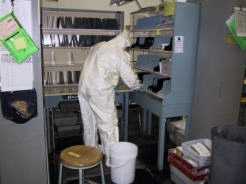Interview with James M. Hughes, M.D.

James M. Hughes, M.D.
What was CDC’s role in responding to the 9/11 tragedies?
Consultation and support for NYC and DC health departments in numerous activities; deployment of National Pharmaceutical Stockpile (NPS) pushpack to NYC.
What was CDC’s role in responding to the anthrax attacks?
National surveillance; epidemiologic investigations in collaboration with state and local health departments; support for state public health labs through the Laboratory Response Network (LRN); laboratory diagnostic support through the Rapid Response and Advanced Technology Laboratory (RRAT Lab), Anthrax Laboratory, and Pathology Laboratory for case confirmation; clinical consultation; professional and public education; advice on postexposure prophylaxis; deployment of antimicrobial agents and supplies through the Vendor Managed Inventory of the NPS; consultation on environmental decontamination; development of treatment recommendations.
How did the CDC work with state and local health departments during the response efforts to 9/11 and the anthrax attacks?
Deployed field teams to Dade County, NYC, NJ, Washington, DC, and CT to assist state, local, and district health departments in ongoing investigations of cases, surveillance, and outbreak control. Staff from CDC Ft Collins, CO assisted state and local authorities in the investigation of a suspect case there. Assisted LRN laboratories in the assessment of numerous powders. Received and processed numerous clinical and environmental specimens and provided reference diagnostic services. Assisted in coordination of epidemiologic and law enforcement investigations.
How would you characterize the response efforts? What were the most difficult aspects to respond to?
Response efforts were generally effective, given resources available at the time. Major challenges related to uncertainties regarding who was in charge at the national and local levels, dealing with the 24 hr news cycle, staying ahead of CNN in release of information, maintaining situational awareness (worked best in NYC), keeping the clinical and public health communities informed, communicating clear and consistent messages, characterizing powder preparations associated with cases (including concerns about indicators of weaponization), sharing information among many agencies involved in the investigation.
What were the biggest challenges or gaps? How have those changed or been addressed during the past decade?
 Initial lack of an Emergency Operations Center and experience with incident command structure and operations. Maintaining situational awareness in all involved areas. Risk communication. Responding to 24 hour news cycle and staying ahead of media in release of information. Meeting the “need to know” requirements of numerous individuals and organizations. Meeting need for rapid development of recommendations for post-exposure prophylaxis. Maintaining relationships with Department, White House, and law enforcement. Expanding CDC laboratory capacity. Coping with fatigue and burnout. Considerable progress has been made in addressing each of these issues though challenges remain.
Initial lack of an Emergency Operations Center and experience with incident command structure and operations. Maintaining situational awareness in all involved areas. Risk communication. Responding to 24 hour news cycle and staying ahead of media in release of information. Meeting the “need to know” requirements of numerous individuals and organizations. Meeting need for rapid development of recommendations for post-exposure prophylaxis. Maintaining relationships with Department, White House, and law enforcement. Expanding CDC laboratory capacity. Coping with fatigue and burnout. Considerable progress has been made in addressing each of these issues though challenges remain.
Looking back, has your perception of the attacks or the response changed from how you saw them ten years ago?
Anthrax attacks ushered in a new era in outbreak preparedness and response at national, state, and local levels. CDC and the nation are much better prepared to respond today. The attacks drove home the reality of the threat posed by terrorism and the need to be prepared to address the unexpected. Numerous challenges remain, two of which are lack of surge capacity of the healthcare system in today’s just in time economy and vulnerability to cyberterrorism.
If there were another anthrax attack today, do you think the response would be different? How?
Greater familiarity with clinical and epidemiologic features of the disease (old dogma would be ignored). Situational awareness, coordination among agencies, incident command, emergency operations, risk communication capacities much improved. Management of complexity of social media environment and timely provision and administration of medical countermeasures would be challenging.
What do you think are the biggest threats or challenges to bioterrorism preparedness today?
Complacency (10 years have passed without another major incident) leading to funding reductions which negatively impact state and local preparedness efforts. Lack of healthcare surge capacity and medical countermeasures including new antimicrobial agents to address the threat posed by genetically engineered organisms which is markedly increased today compared with 10 years ago. Just in time economy introduces additional preparedness challenges.
What remains to be done to make sure that we can respond effectively to bioterrorism attacks?
Maintenance of political will. Strengthened national and global biosurveillance capacity to ensure early detection and situational awareness. Continued support for medical countermeasures development Elimination of barriers to sharing of critical information including etiologic agents during emergency responses. Strengthened biosecurity and biosafety programs internationally. Support for effective implementation of IHR 2005 in all countries, including the US.
- Page last reviewed: March 19, 2014
- Page last updated: March 19, 2014
- Content source:


 ShareCompartir
ShareCompartir